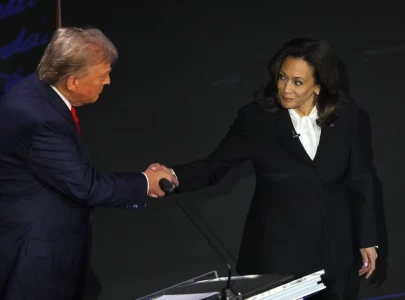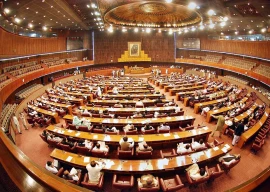
“I told the producers not to touch this script,” he tells The Express Tribune, with amusement, “I thought it was not a cinema film.”
Fortunately, the producers Khurram Rana, Badar Ikram, and Sahir Rasheed persisted, encouraged and practically forced an unconvinced Sehbai, who relented, “They took a daring step because nobody would put money in Meer Taqi Meer at all. Nobody would even look at it.”
Sarmad Sehbai’s work as a poet, author, playwright and filmmaker highlights his innovative approach to art and culture. His vision is reflected in the diverse mediums and languages he works in, from poems to PTV dramas (Naya Qanoon, Toba Tek Singh), theatre plays (The Dark Room), a documentary (Mughals of the Road) and most recently Laa. His work constantly questions defined norms and now with Mah-e-Meer, even madness.
With the current cinema landscape of awaited films with patriotic agendas (Operation 21), mad-cap comedies (Namaloom Afraad), burning social issues (Dukhtar), and a possible remake of a gandasa yielding Maula Jutt, why would anyone be interested in a film on the eighteenth century poet?
Even the producers played around with the more accessible title Poora Chand concerned that audiences were unfamiliar with Meer, but eventually they decided to tell them who Meer is and the symbolism of the moon lent itself to the title Mah-e-Meer.
His fears though were unfounded as his cast and crew were mesmerised by the dialogues while shooting and the now famous line from the trailer, “hum yeh tau nahin kehtey kay ghalib kehta tha ya Meer kehta tha, hum tau kehtey hain, Meer kehta hai” has captured the imagination of many.
The strong visuals, colourful characters of the past contrasting sharply with the dusty reality of today have piqued the curiousity of many, so much so that “people have developed a romance for Meer,” he recalls with surprise.
He tamps down the hype surrounding the film claiming that it is not a biography but rather an interpretation of Meer’s experiences.
Not a biopic
It’s no surprise that Sehbai, an accomplished poet himself, sought Meer as an inspiration. Flitting between the past and the present, the film fuses the story of a contemporary poet– an anarchist, who destroys traditions and experiences madness when he falls in love with a woman who appears to him through the full moon, mirroring Meer’s junoon.
“The whole film is inspired by that experience” he explains.

In exploring Meer’s past, was there ever a danger of romanticizing the exotica related to the grand old Islamic past?
“The tawaif actually embodied the whole cultural metaphor of the fall of the Mughal Empire,” says Sehbai. There was a loss of beauty and pleasure embodied in courtesan culture along with a loss of power, he elaborates. Eventually what survives is art, not the Mughal Empire, as is true throughout world history. Power merely serves as the backdrop to how these stories unfold and this is alluded to in Mah-e-Meer as well.
Getting the act together
As with any independent film, co-directors Sehbai and Anjum Shehzad had their share of juggling budgetary constraints and shooting in the brutal heat of Lahore and Karachi.
Sehbai fondly recalls working with the actors to create powerful visualisations of the characters through certain mannerisms, enriching them with the subtext and nuances.
Sehbai whets our appetite further saying that most people are surprised at the performances he can elicit. “This is what is going to happen with Iman (Ali), with Fahad (Mustafa), with Sanam (Saeed) and with Manzar Sehbai” he enthuses.
His attempt is to allow a more visual interpretation through the physical presence and movement of actors moving away from a very text oriented society to a more visual one. Expounding on this further, he talks of older actors and their statue-like stances projecting their voice, without moving their body. He maintains that we are still discovering the power of the visual and how to create the ambience on the screen and charge it with emotions and nuance.
Some of this harks to how we perceive masculinity in our culture even though perceptions are changing.
“Even India totally changed from Dilip Kumar to Shah Rukh Khan but in Pakistan it is the repression of the body. They body is not considered something sublime or something respectable in that sense. Even in Pakistani films I don’t think you will see the body being celebrated.” Sehbai says.
Pseudo new wave
So then, what are Sehbai’s views on the new wave of Pakistani Cinema? Wary of “pseudo, new wave, feel-good terms,” he cites the growth of an urban audience that seeks a different kind of film pointing to the emergence of the English theatre scene. He says multinationals helped build Pakistani English theatre for the middle classes who “in their upward mobility have forgotten about changing society or bringing in the revolution” he reflects.
If, he says, you try to understand the emerging film landscape in sociological terms, why a Khuda ke Liye or a Bol was made, we need to refer back to the tiff between the civilian government, the army, democracy along with the old somewhat altered adage - follow the funding, which is mainly from the army or NGOs.
He believes that a film can only transcend to art in the hands of the artist, who can invisibly subvert the funders agenda as Satyajit Ray’s classic film Pather Panchali did by subverting UNICEF’s agenda of making a film about poverty.
As for his own works, Sehbai denies any interest in commercial filmmaking and refuses to adopt airs either for himself or his project. Mah-e-Meer’s script was written quite a few years ago and his aim is to see his vision completed rather than pleasing the classes or masses. “I just enjoy multiplicity and different art forms and I have my pleasure.” he says.
Search for a Pakistani idiom
As writer and co-director of Mah-e-Meer, Sehbai can exercise his creative control on the film. As the film heads to post production, Sehbai leaves us with these final thoughts.
He believes Pakistani cinema is struggling to find its own authentic idiom. The audiences are looking for something that they can own and be proud of. “In this film, we have tried to discover that” he says.
While on the surface, Mah-e-Meer presents a picture of love and madness, Sehbai’s true search lies in the rediscovery of heritage, poetry, literature, and music within our traditions.
“It’s a great opportunity for the new Pakistani generation to find out about their heritage” he muses. Dismissing any claims of a grand experiment, Mah-e-Meer he says is, “very simple, it’s like a whisper, it’s like a long poem.”
Additional input by Randeep Bakhshi.
Sadaf Haider and Sadaf Siddiqui run their own website called dramapakistani.net.
Correction: In an earlier version of the story, the URL was incorrectly written as dramapakistan.com instead of dramapakistani.net.
COMMENTS (11)
Comments are moderated and generally will be posted if they are on-topic and not abusive.
For more information, please see our Comments FAQ










1726140338-01730723472-0/Untitled-design-(42)1726140338-01730723472-0-270x192.webp)




1730706072-0/Copy-of-Untitled-(2)1730706072-0-270x192.webp)
The best part of the write up is the video where Ghalib appreciates Mir. looks like ET is no longer run my a bunch of high school kids trying to make sense
thank you for reading the article . the trailer alone is so fascinating , the film can only be better. A correction though the website is www.Dramapakistani.net .If anyone has any questions we would be happy to answer them
Looking forward to this movie.... Judging from the film it maybe the type of film which reflects our beautiful south-asian culture
@Sameer
If you think that Iqbal was merely an "above average" poet, who shouldn't be placed with Meer and Iqbal, you really need to know a lot more about Urdu literature. Try listening to Ahmad Javaid sb's lectures on Iqbal available on YouTube, and try reading Iqbal in more depth. I would also suggest reading Shamsur Rahman Faruqi's "Khurshid ka Saman-e-Safar".
Faiz was an outstanding poet but not in the league of the big three.
Great piece! This trailer which has been doing the rounds for a while has really made me curious about the film and about Meer as well. It's always good to get insight into the wrtiers creative process and all the thinking that goes behind the making of the film.
I think the website you've listed however is dramapakistani.net
Please correct the link. The website is dramapakistani.net
@Taimoor: "Meer. Ghalib Iqbal. -Urdu poetry-"
Many count Faiz Ahmed Faiz after Ghalib, instead of Iqbal, whose contribution lies in introducing Nietzschean thought in Urdu.
@Taimoor: Please don't put Iqbal in the same sentence with Mir and Ghalib. Iqbal was an above average poet. Their true successor during modern times was Faiz.
Can't wait for this . Wishing him all the best .
Meer.
Ghalib
Iqbal.
-Urdu poetry-